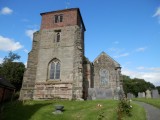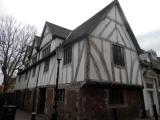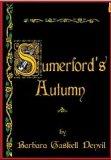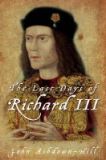A report from the 11th Triennial Conference of the Richard III Society,
Loughborough, 20 – 22 April 2012
Well, it is months since I attended the Triennial Conference in the UK and I will say that I enjoyed it immensely and would go again tomorrow if the opportunity arose, but I somehow feel that the events of the more recent months have almost overshadowed my experience. Within weeks of my return to Australia the Greyfriars Dig commenced and next we have skeletal remains which may well be those of Richard himself.
However, at the Conference we were delighted by the presentations from the two academics who had made such monumental discoveries of the battlefields of Bosworth and Towton, and I will go into these presentations a little more.
Recent years have been good for investigation and discovery regarding Richard, the Yorkists and our Society.
You will already be aware of the programme for the triennial conference and if I was asked to choose which was my favourite it would be a hard call. However, I think the tour of the new site for the battle of Bosworth was the most thrilling, followed by the presentation by Mark Stretton on the ‘Power and Effectiveness of the Warbow in Battles’.
We were also treated with a presentation by Dr Glenn Foard, the person responsible for identifying the new Bosworth and discovering all the wonderful artefacts which have generally enlightened thought on late medieval warfare. In his presentation he not only brought the long and arduous investigation to light, but we heard about the importance of the discoveries of the great number of cannon balls found at Bosworth.
In terms of the confirmation of the site, the identification of the marsh, which was confirmed by soil sampling and then the analysis of the landscape, which matched the historical records, meant that the new site was now undisputed.
Dr Foard told us that artillery and guns were known to have been crucial to battle strategy and at the time were known to be important weapons of the future. It was also interesting to know that there were no arrowheads found in the area, unlike the number of arrowheads found at the Towton battlefield site. In addition, there was not the quantity of evidence at Bosworth that was found at Towton, and Dr Foard thought this was attributed to the fact that the battle of Towton resulted in the deaths in battle of a far greater number of nobles than were killed at Bosworth. At Bosworth a number of artefacts were found where the action was concentrated, and this was where the silver boar brooch and a fragment of the hilt of a gilded sword were found.
Dr Foard explained that the Bosworth discovery increased the understanding of the use of firepower and there was not much evidence of the use of handguns at Bosworth, unlike on the Continent and in Burgundy. The evidence suggested that a bigger calibre was used at Bosworth, lead with flint, lead with stone and iron with iron. It is also now thought that the Wars of the Roses were important battles for the development of artillery and the evidence supports this theory. The findings at Bosworth provided evidence of the battle tactics that were deployed at the time and also that the pressures and temperatures of different materials used to make guns were well understood by the commanders at the time. For instance they understood muzzle velocity, whether to elevate guns or to fire point blank, that the cannon balls bounced on the ground and the angle of elevation that was needed to maximise the bounce and therefore increase the opportunity of hitting a target. Dr Foard thought that gunpowder was the determining factor in the development of artillery and guns.
The actual battlefield is now a working farm and great pains have been taken to conceal the actual site from the public, to avoid hoards of amateurs using metal detectors and collecting artefacts but who would also damage the site and interrupt the farm. The farmer and his wife were very charming people who felt honoured and thrilled that such an important historical event occurred on a site they now own. In this, everyone is very fortunate to have such custodians, who in conjunction with archaeologists and serious academics, will ensure the preservation of the site until it has been thoroughly and scientifically investigated so that all archaeological evidence can be properly collected and studied. Dr Foard said there was much more work to be done on the site as it had not been fully surveyed, and this could take years of work to complete.
I must say, it was a thrill to visit the site, it was a special occasion where I got a true sense of battle that took place and the spot was pointed out where it was thought the battle was most intense, and where it was suspected that Richard had lost his life.
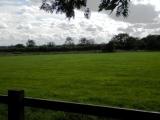
A view of a section of the new battlefield from the trail at the Bosworth Battlefield Heritage Centre which opened up new avenue of research and is awaiting further archaeological investigation. (photo by Dorothea Preis)
The next lecture I most enjoyed was by Mark Stretton on the ‘Power and Effectiveness of the Warbow in Battle’. This was extremely informative and entertaining. Mark has been entered in the Guinness Book of Records as an archer, he is a master arrowsmith and has made an in-depth study of his craft. Through study and experimentation Mark has identified the uses for each type of arrow head from the period, its effectiveness in piercing armour and the amount of damage it was intended to inflict. He told us that the bodkin type of arrowhead was the most commonly used because of its ability to pierce armour and was more likely the type used in battles around this period. It will be interesting to hear any comments he has to make regarding the arrowhead found in the human remains recently discovered in the Leicester car park as I understand that this arrowhead was of a shape thought to be used for hunting boar (funnily enough!!) and is very different to the bodkin-type arrowhead and apparently not known for its ability to pierce armour. It will be great to hear any comments about this and whether Mark will revise his thoughts, or indeed have any other comments to make.
Mark also explained that the greatest vulnerability to arrow shot, was in areas of the body where the armour was weakest, that is in the arm pits, elbows, groin and legs. He also made the further comment that from a tactical point of view, an arrow wound would cause a nobleman to die slowly and when the nobleman was hit, it took the attention of his retainers, giving a tactical advantage to the opposing side. These are unpleasant thoughts.
And as a last interesting comment, another presenter Tobias Capwell who is the Curator of Arms & Armour for the Wallace Collection in London, gave an interesting presentation on armour and how he thought it was pregnant with meaning – how it was an indication of status and wealth. He thought Richard, on going into battle, would have worn a surcoat over his armour which was made of rich material, probably silk with gold embroidery. The armour he wore at Bosworth was probably fully gilded and probably looked like a golden mirror and would have been worth several millions of dollars in modern currency. This would have been evidence of conspicuous consumption; however this would have been expected of a King. The armour or the surcoat could also have had jewels and pearls embedded in them.
Tobias explained that a king’s splendid armour was like a beacon on the battlefield, soldiers were drawn to it, he led from the front, the imagery was very important. But the wealth displayed by the armour worn, by the King or his nobles, even though it caused enemies to be drawn to them on the field, it was also seen as an insurance policy – capture me, don’t kill me, I am worth saving as my ransom will be worth it to you.
The Conference was great and I’m really going to try to get to the next one. I hope you can too.
Tags: Battles, Bosworth
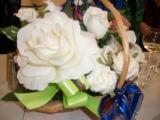 Members and Friends of Richard III NSW Branch are invited to the annual service commemorating the death of Richard III and many of his followers at the Battle of Bosworth, on 22nd August, 1483
Members and Friends of Richard III NSW Branch are invited to the annual service commemorating the death of Richard III and many of his followers at the Battle of Bosworth, on 22nd August, 1483
